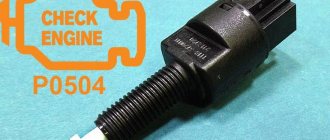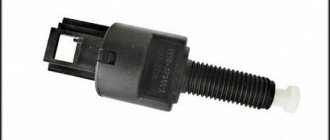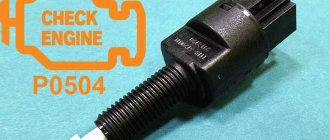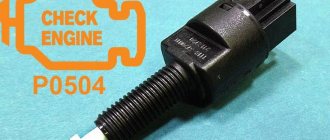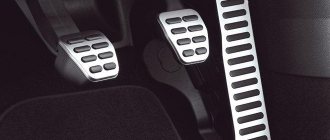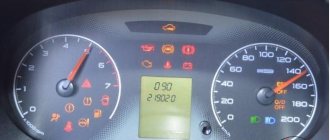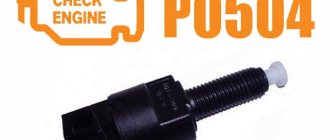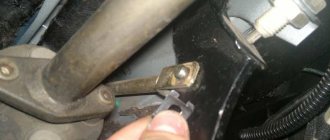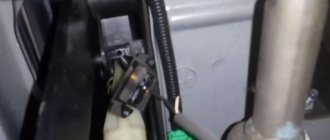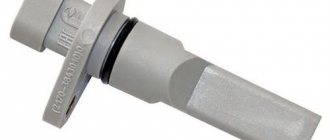Owners of LADA cars with an electronic gas pedal may encounter error P0504 (mismatch of brake pedal sensors). Along with it, malfunctions in the engine may appear (stalls, speed fluctuates, does not start, etc.). Most often the cause is the brake pedal position sensor (brake light sensor or frog).
The brake pedal position sensor and brake light switch are mounted in one housing. Most often, the cause of its malfunction is a broken spring. In this case, you can repair the sensor yourself by replacing the spring with a new one. Or replace the sensor with a new one.
Brake limit switch VAZ 2114
Handbrake light (LR) - an indicator on the dashboard in the form of an exclamation mark with curved lines on the sides (sometimes there is the inscription Brake).
Indicates that the car is on the parking brake (ST). Possible causes of the problem:
the harnesses have become frayed as a result of long-term use;
failure of the ST cable under the influence of external factors;
frequent emergency braking.
The optimal solution would be to replace the worn part.
Wiring and light bulbs are common factors in code 0504.
Again it is worth paying attention to the components.
If the owners of the Granta did not leave reviews, it would be incorrect to blame the functioning brake lamp for a malfunction. However, this point does occur. The active spiral of the 1-pin brake light bulb stretches over time, while the antennae that hold it close with the rest. In this situation, it makes sense to install new brake lamps, which can help correct error P0504. Possible causes of the Check Engine error and alert may be:
- burnt contacts on the limit switch;
- weak contact of the light bulb base;
- short circuit of the brake light power supply wiring.
These errors are easy to check. There is a voltage at the sensor supply wires of 0.12-0.15 V - which means you need to look for a short circuit or oxidation on the contact blocks/boards. Note that there should be no voltage on the supply wires.
Error P0504
This malfunction is associated with an incorrect signal from the brake pedal switches. Most often, the cause of such a failure is a malfunction of the brake pedal position sensor, lack of proper adjustment, or a broken spring that is installed in this device. Procedure for checking and troubleshooting:
- We remove the sensor;
- Move the rod lock to the right position using a screwdriver;
- We use a multimeter with an ohmmeter function;
- On Largus, Vesta and Xray cars, contacts 3-4 should be closed and have a resistance close to zero. Contacts 1-2 are open and their resistance should tend to infinity.
- When you press the rod on contacts 3-4, the circuit opens, and on contacts 1-2 it closes. If this is not the case, then the sensor must be replaced.
- On Priora, Kalina, Granta, Niva cars, contacts 1-4 should be closed, and 2-3 open. When you press the rod, the situation is the opposite.
- Before reinstalling the sensor, move the rod to the left position.
Sensor locations on video:
Adjusting the brake pedal position sensor:
Any driver can carry out this procedure at home without a trip to a service station. The part has two nuts in its design. One of them is on top, and the second is on the bottom. The upper nut adjusts the pressure of the rod. First you need to release the lower one, and then tighten the upper one, thereby changing the gap of the element. You need to ensure that the rod is fully pressed and not partially pressed. After this, start the car and let it run for about 10 minutes to check if the error appears.
Brake pedal sensor Lada Granta / Kalina-2, Datsun (old model)
Brake pedal sensor (brake signal switch) Lada Granta / Kalina-2, Datsun (old model).
To connect the sensor, you may need a sensor connector.
Product characteristics
We recommend watching
Connector for connecting the brake pedal sensor 1118-3720010 old model for Lada Gran..
New items
Original factory trim for the left (driver) seat on the inside for Lada Vesta. The cladding will need to be replaced..
LED fog lights with low and high beam from the manufacturer Sal-Man with 7 lenses. The headlights are suitable for cars:..
LED rear bumper fog lamp for Lada Granta (liftback) and Vesta (all body types) cars with a pattern in...
LED rear bumper fog lamp for Lada Vesta cars (all body variants) with the inscription VESTA. Lantern mouth..
LED fog light in the rear bumper for Lada Granta (liftback) cars with the inscription GRANTA. The lantern is installed..
Reversing lamp GE / TUNGSRAM. Power: 16W Voltage: 12V Brightness, lm: 310 Base: W2.1×9.5d ..
Car lamp R10W 12V GE, used in the rear lights of Lada Granta (liftback and station wagon), Kalina-2, Datsun Mi-Do and others..
The turn signal lamp is orange, applicable for cars Lada Largus, Niva, Vesta, Xray, Granta, Kalina, Kalina-2, Priora, ..
Caliper repair kit for Lada Niva (4x4 Legend), Chevrolet Niva, Niva Travel. Includes: 21210-3501051-00 ring..
Camshaft plugs for the 16-valve K4M Lada Largus engine, set of 2 pieces. ..
This product belongs to a group of products that are manufactured (painted) individually for each customer. This item is shipped..
Rear bumper diffuser for Lada Granta FL sedan. The texture of the plastic is shagreen. The diffuser is installed using a double...
Original standard anti-roll bar with a diameter of 24mm for Lada Granta, Kalina-2 and Datsun cars, assembled...
A set of original front and rear plastic fender liners with sound insulation for the Lada Niva Travel car. The price is indicated..
A set of original front and rear plastic fender liners with sound insulation for the Lada Largus FL car (except Cross) (from March..
A set of original front and rear plastic fender liners with sound insulation for the Lada Largus Cross FL car (from March 2021.
A set of original front and rear plastic wheel arch liners for Lada Vesta sedan and SW (station wagon) models..
Set of rubber interior carpets with honeycomb-shaped cells for Lada Priora (any body). Avtodriver car mats -...
Causes of error P0504 Granta
An error regarding an incorrect signal from the brake pedal switches occurs in some cases solely due to an unadjusted limit switch. The fact is that after reflashing the electronic control unit M 74 and M 74.9.7, engineers made some adjustments to the engine control algorithm, which ultimately should have affected the reduction of harmful emissions. In practice, changing the firmware only strangled the engine and caused a bunch of problems with sensors and limit switches.
The Lada Granta has both a brake pedal position sensor, a limit switch and a brake light switch installed in one housing. The first reason for the appearance of error P0504 is incorrect adjustment of the position of the sensor housing.
How to adjust the Grant brake pedal sensor
The sensor is fixed to the bracket with two nuts screwed onto a plastic housing. The upper nut is responsible for the position of the sensor relative to the brake pedal. The nominal gap between the pedal platform and the heel of the sensor should be 2-3 mm when the pedal is fully released.
If there is no gap, the sensor may be triggered at the slightest touch of the pedal, which leads to error 0504 and activation of the Check Engine warning light. After simply adjusting the gap with two keys, we start the car and look for errors. P0504 will not reset immediately, but if the problem was an adjustment, the error code will disappear after 10-15 minutes of running the engine at idle speed. If this measure does not help, we check and look for the reason further.
Broken brake pedal sensor
One of the likely reasons for the appearance of this error on Grant is a malfunction or defect of the brake pedal end itself. The quality of AvtoVAZ components has always left much to be desired, and this happened this time too. Even domestic sensors, as a rule, are equipped with cheap Chinese springs and contacts. As a result, the springs break and the contacts simply burn out after 5-8 thousand mileage.
Additional Tips
Before each trip, especially over long distances, you should check the functionality of all lighting equipment, including brake lights. In order to reduce the likelihood of breakdowns along the way, you need to periodically check the condition of the sockets and bases of the rear light bulbs, and periodically clean them of oxides and dirt.
In case a breakdown does occur, you should always have an additional set of light bulbs and 10 amp fuses in your car, as well as a multimeter to check them.
Instructions for replacing the brake controller
- Pump out the liquid.
- Place the vehicle on a support stand and remove the wheel.
- Use a wrench to unscrew the two wheel pins.
- Remove the brake drum.
- Then, using a screwdriver, pull out the hook of the upper tension spring and remove the part. Perform the same manipulation with the lower tension spring.
- Then remove the front pad and spacer bar, while disconnecting the pressure spring and lower the pad.
- Remove the shoe lever from the parking brake hole, straighten the cotter pin and remove it from the parking brake drive.
- Remove the washer and lever.
- Install a new block and assemble the part in the reverse order.
Rear disc brakes on Lada Kalina
Checking the brake fluid level
The brake fluid level is checked periodically: daily during vehicle operation, during each maintenance, after operations to pump the brake system hydraulic drive and replace the brake fluid, when a warning lamp lights up on the instrument panel, indicating an insufficient level of brake fluid in the master cylinder reservoir.
1. We prepare the car for work.
2. Use a rag to remove dirt from the master brake cylinder reservoir.
3. Visually check the brake fluid level in the reservoir. It should be between the MIN and MAX marks on the tank body.
4. Check the degree of wear of the brake pad linings of the front and rear brake mechanisms.
5. If the wear of the brake pads is within normal limits, and the fluid level in the reservoir is below the MIN mark, then disconnect the tip of the wiring harness from the emergency brake fluid level drop sensor, unscrew and remove the reservoir cap.
6. Add new brake fluid to the reservoir up to the MAX mark (when installing the reservoir cap, the sensor float will be immersed in the liquid and its level will increase).
7. Close the tank lid tightly.
8. Connect the wiring harness block to the sensor connector.
9. Check the operation of the emergency brake fluid level sensor: with the ignition on, press the rubber lining of the reservoir lid from above. If the sensor is working properly, the warning lamp on the instrument panel will light up.
When is pumping required and how to prepare for it
Bleeding the brakes is not always necessary - if the brake system is functioning properly, then bleeding is not necessary.
It is required only in the following three situations:
- When the pedal begins to “fail” (as was mentioned at the very beginning of the article).
- After replacing any component of the brake system.
- After replacing the fluid.
All these situations are caused by one single reason - air entering the system. So, if the pedal began to “fall” by itself, then, most likely, the brake tract was depressurized in some area, and air leaked inside.
When replacing parts, air also enters the brake system in large quantities and remains inside, causing its failure (the same applies to a complete replacement of the brake fluid).
Malfunction of the lights themselves
If during the check from the fuse box to the limit switch no problems are found, then you should move on. Now you should test the wiring from the second limit switch connector to the stop connectors with a tester. If it is working, then you need to check the board. The printed circuit board on which the taillights are mounted is not ideal, and is one of the biggest problems of all VAZ cars.
Its tracks often burn out or peel off, causing the lights to stop working. This problem can be solved in two ways - either re-solder the tracks (which can be done with a regular soldering iron, although not in road conditions) or replace the board with a new one (most motorists choose the second option).
Another reason why the VAZ 2114 brake lights do not work may be oxidation of the lamp sockets. In order to eliminate this problem, it is enough to clean all contacts from oxides that have appeared on them.
This is best done in one of the following ways:
- small grit sandpaper;
- WD-40 solution;
- kerosene;
- purified gasoline (“galosh”).
You should absolutely not use gasoline or other solvents to clean contacts.
The last option for faulty stops is the light bulbs themselves. It makes no sense to give any detailed advice here - you just need to replace the burnt out light bulbs with new ones.
By following all the tips listed above, the car enthusiast gets the opportunity to check the entire electrical circuit of the brake lights, starting from the fuse box and ending with the bulbs in the lamps. Thanks to this, the guarantee that the fault will be accurately detected and eliminated is 100%.
When is clutch adjustment required?
VAZs use a dry type of clutch, that is, there is a basket consisting of two parts - driving and driven
Clutch adjustment of the VAZ 2114, and other vehicles, is carried out in cases where defects associated with the operation of this mechanism appear. Such malfunctions include:
- clutch pedal adjustment;
- clutch cable adjustment;
- pedal height adjustment;
- clutch adjustment.
In another case, the need to adjust the clutch drive may arise due to previous incorrect adjustment. It is possible to reduce or increase the working stroke of its pedal.
The photo shows the clutch of a VAZ 2114
As a result, malfunctions occur in the operation of the drive - the clutch begins to “slip” or “drive”, gear shifting becomes difficult, jerks appear when starting from a standstill, fuel consumption increases, etc.
Checking brake pad wear
We check the degree of wear of the brake pads of the front brake mechanisms in the following sequence.
1. Place the car on the inspection ditch.
2. Remove the front wheels.
3. When checking the pads of the left brake mechanism, turn the steering wheel completely to the left, and when checking the pads of the right brake mechanism, turn it to the right.
4. Through the inspection hole in the movable caliper bracket, we visually determine the thickness of the brake pads.
If the thickness of the lining of at least one pad is less than 1.5 mm, we change all the brake pads of the brake mechanisms of the right and left wheels.
Methods of attaching a brake light to a car
To secure a brake light, there are a couple of methods:
— regular Velcro is a good attachment to the rear window; — a special bracket is also a reliable mount, but it will require you to make a hole in the rear shelf.
When replacing an additional brake light or installing it in a spoiler, you need to check whether there is room for the wires. The wires must be routed inside the trunk to the main circuit of the machine. The positive wire must be connected to the brake light terminal. The negative wire goes to the body.
To prevent the reins from being visible, they are attached to the bottom of the trunk. Electrical tape will do for this. But you can also include them in a common bundle. Every exposed part of the wire must be insulated.
IMPORTANT! To connect such devices, you can choose one of many schemes. In many of them, you can independently regulate the period of blinking and the frequency of flashes. But for this you need to configure the appropriate resistors.
You can also use the rear brake lights as a fog light. Then they will light up constantly and not blink. There is also a connection diagram where the lamp will work as a fog light, and as soon as you press the brake, it flashes.
The principle of operation of the brake light
The brake lights are located at the rear of the car. Red lanterns. They light up automatically if the driver brakes. When the driver takes his foot off the brake pedal, they are also automatically turned off. The presence of stops is mandatory for vehicles.
The lights should be located symmetrically and burn brighter than the side lights. Brake lights are installed on the sides, on the rear window, in the center above the line of the side stops.
Primary and secondary brake lights can be a single bulb, a neon tube, or a set of LED bulbs. The car enthusiast is additionally equipped with a brake light repeater. The rear brake light can also serve as a fog light. You can install a formula 1 brake light (the author of the video is Mikhail Ermolaev).
The simplest brake light includes a breaker (switch) and a flashlight. The brake light switch is often called the frog switch. The plastic body of the breaker contains two terminals, a rod and a spring. This device is installed on the brake pedal.
When the driver presses the pedal, the rod enters the breaker body, the contact closes and the light comes on. As soon as the driver removes his foot from the brake pedal, the spring pushes out the rod, the contacts open and the light goes out.
